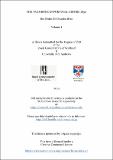Files in this item
The trombone in Portugal before 1850
Item metadata
| dc.contributor.advisor | McGrattan, Alexander | |
| dc.contributor.author | De Oliveira Alves, Rui Pedro | |
| dc.coverage.spatial | 2 v. (xxi, 152, 210 p.) | en_US |
| dc.date.accessioned | 2018-10-30T10:55:30Z | |
| dc.date.available | 2018-10-30T10:55:30Z | |
| dc.date.issued | 2014-06-26 | |
| dc.identifier.uri | https://hdl.handle.net/10023/16353 | |
| dc.description.abstract | This thesis examines the use of the trombone in Portugal between the first references to its use in the early sixteenth century and the mid nineteenth century. It is primarily based on archival research and supplemented by literary and iconographical references. This material is presented in calendar form in Volume II as Appendix 1. Volume I consists of a series of chapters that analyse and contextualise material from the Calendar. For the earlier period the thesis focuses on the use of the trombone in royal service, and in doing so provides a detailed survey of the Portuguese royal shawm band. The use of the trombone outwith royal service it is also examined. Issues relating to terminology and instrument making in Portugal are discussed. By examining sixteenth century iconographical sources with links to Portugal, this study addresses questions concerning aspects of trombone technique that have not previously been considered and have implication elsewhere in Europe. It considers the decline of the trombone during the second half of the seventeenth century and its resurgence in the later years of the eighteenth century. It identifies the earliest orchestral repertoire containing trombones that emerges in Portugal during the last decade of the eighteenth century, as well as the first trombone players of the beginning of the nineteenth century in military bands and orchestras in Lisbon. Finally, the thesis considers the class of brass instruments of the Royal Conservatoire of Lisbon and its professors, and examines the earliest surviving trombone methods in Portugal, which introduce aspects of performance practice that are not mentioned in other contemporary sources. | en_US |
| dc.description.sponsorship | "This research was funded by “Fundação para a Ciência e a Tecnologia” (FCT, Portugal) through the Ph.D. grant with reference SFRH/BD/43686/2008, and was co-financed by the European Social Fund (Fundo Social Europeu) within the program POPH - QREN - Tipologia 4.1 - Formação Avançada” and by national funds from the MEC." -- page x | en |
| dc.language.iso | en | en_US |
| dc.rights | Attribution-NonCommercial-NoDerivatives 4.0 International | |
| dc.rights.uri | http://creativecommons.org/licenses/by-nc-nd/4.0/ | |
| dc.subject.lcc | ML965.D4 | |
| dc.subject.lcsh | Trombone--Portugal--History | en |
| dc.title | The trombone in Portugal before 1850 | en_US |
| dc.type | Thesis | en_US |
| dc.contributor.sponsor | Fundação para a Ciência e Tecnologia (Portugal) | en_US |
| dc.contributor.sponsor | European Social Fund | |
| dc.contributor.sponsor | Portugal. Ministério da Educação e Ciência | |
| dc.contributor.sponsor | Leverhulme Trust | en |
| dc.type.qualificationlevel | Doctoral | en_US |
| dc.type.qualificationname | PhD Doctor of Philosophy | en_US |
| dc.publisher.institution | The University of St Andrews | en_US |
This item appears in the following Collection(s)
Except where otherwise noted within the work, this item's licence for re-use is described as Attribution-NonCommercial-NoDerivatives 4.0 International
Items in the St Andrews Research Repository are protected by copyright, with all rights reserved, unless otherwise indicated.



